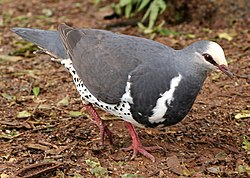Wonga pigeon
| Wonga pigeon | |
|---|---|
 |
|
| Scientific classification | |
| Kingdom: | Animalia |
| Phylum: | Chordata |
| Class: | Aves |
| Order: | Columbiformes |
| Family: | Columbidae |
| Genus: |
Leucosarcia Gould, 1843 |
| Species: | L. melanoleuca |
| Binomial name | |
|
Leucosarcia melanoleuca (Latham, 1801) |
|
| Synonyms | |
|
Leucosarcia picata |
|
Leucosarcia picata
The wonga pigeon (Leucosarcia melanoleuca) is a pigeon that inhabits areas in eastern Australia with its range being from Central Queensland to Gippsland, eastern Victoria, Australia.
Previously they could be found as north as Cairns and as south as the Dandenongs, but due to land clearance, shootings in the 1940s for crop protection, and fox predation, they are rarely seen in these areas, but their populations have improved in these areas.
The wonga pigeon is a large, plump pigeon that has a short neck, broad wings, and a long tail. Its length varies from 38 to 40 centimetres (15.2 to 16 inches). It has pastel blue-grey back feathers. The head fades to a creamy-white colour. The underside is white with dotted dark grey spots such that a white V can be seen on its chest. They eyes are a dark red-brown colour and they have pink eye-rings that encircle them. Legs are red and the sexes appear identical but immature pigeons are browner with a less distinct V pattern.
They are very elusive birds, more often being heard but not seen, producing explosive wing claps when disturbed. They tend to occur on the ground foraging and are located in rainforests, wet eucalypt forests, coastal forests, picnic areas, walking tracks, car parks and gardens. Their diet consists of fruit, berries, seeds from native forest trees and the odd insect.
The call of the wonga pigeon is a loud, high-pitched 'coo' repeated over long periods of time for a number of seconds. When males are displaying mating, bowing occurs with a soft, trilling coo.
...
Wikipedia

